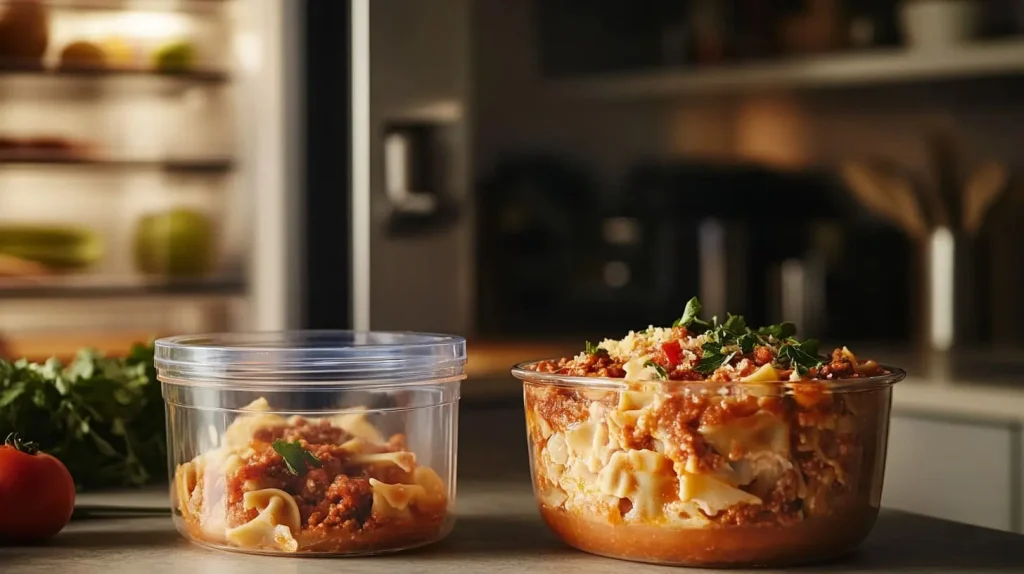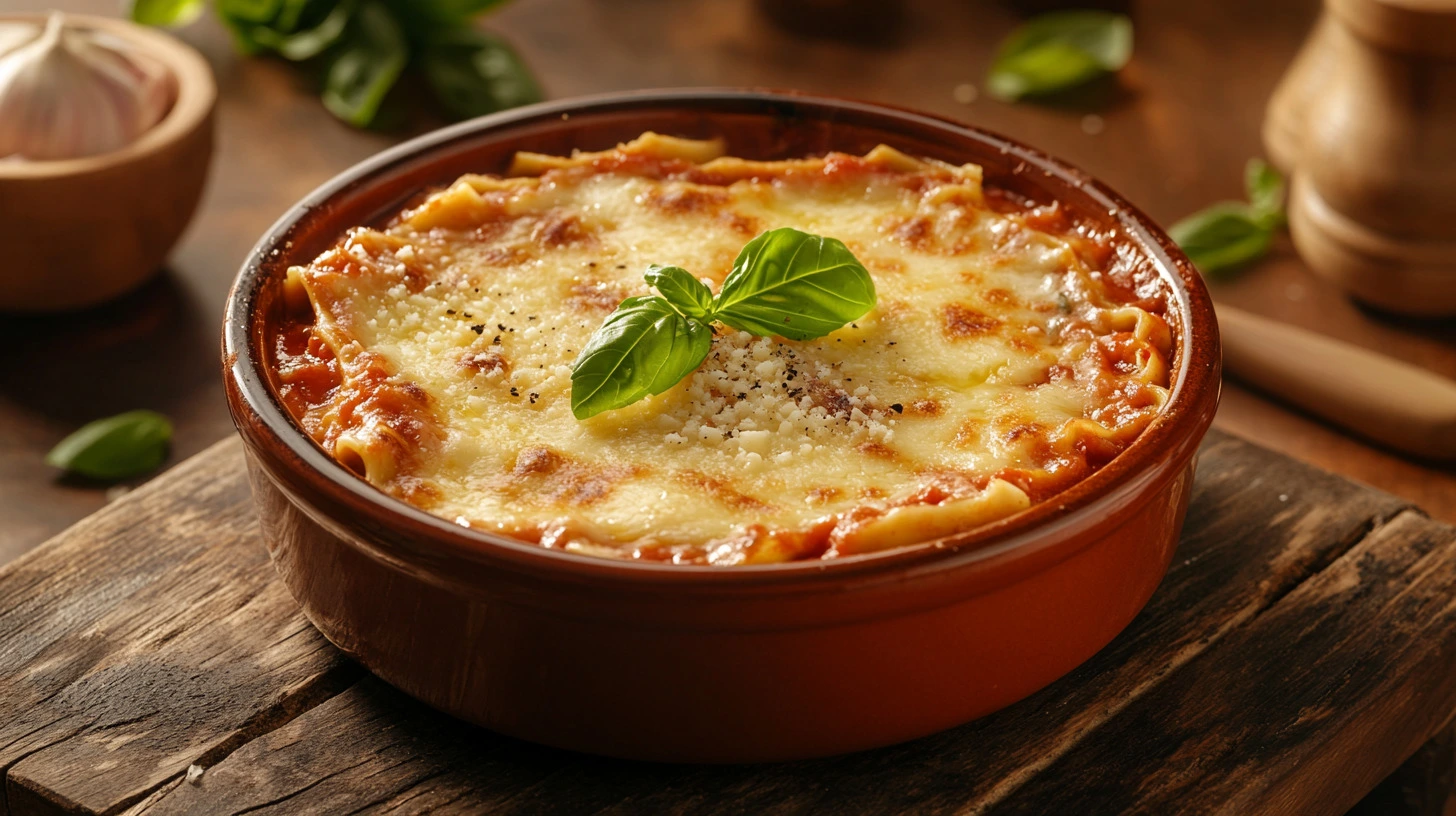The smell of tomatoes, cheese, and noodles reminds me of my grandma’s kitchen. Her lasagna soup was not just delicious, but a memory of comfort. If you’re wondering about lasagna soup fridge storage, knowing how to store it properly is essential for preserving its flavor and safety. Let’s explore the best practices for lasagna soup fridge storage to enjoy it later without worries.
Have you ever wondered how long lasagna soup stays good in the fridge? Knowing this is important. We want to enjoy every bit without worrying about safety or taste. A warm bowl of lasagna soup can brighten up our day.
Main Highlights
- Lasagna soup can be stored in the fridge for 3-4 days when kept at 40°F (4°C) or below.
- Proper lasagna soup fridge storage is essential for maintaining flavor and texture.
- Separating the soup’s components, such as noodles and cheese, can extend its shelf life.
- These lasagna soup fridge storage tips ensure your dish stays safe and delicious for days.
- Freezing lasagna soup is a great option for long-term storage, up to 2-3 months.
- Paying attention to visual cues, smell, and texture can help determine when it’s time to discard the soup.
Storing lasagna soup right is key to enjoying it. It’s about savoring every spoonful. Let’s learn how to keep it fresh and tasty. This way, we can enjoy the flavors that remind us of better times.
A steaming bowl of lasagna soup, richly layered with pasta, melted cheese, and a savory tomato sauce, garnished with fresh basil and a sprinkle of parmesan, set on a rustic wooden table, with a cozy kitchen backdrop.
Understanding Lasagna Soup Basics
Lasagna soup is a comforting dish that combines lasagna flavors in a soup. It’s great whether you stick to the traditional recipe or try new twists. Knowing the key ingredients and how to prepare them helps keep your soup fresh and tasty.
Key Ingredients and Their Storage Impact
The main parts of lasagna soup are ground meat, broken lasagna noodles, tomato-based broth, veggies, and cheese. These items can change how long the soup stays good. For example, cooked and cooled meat and pasta stop bacteria growth. The tomato base and broth also play a role in how long the soup lasts.
Nutritional Value and Preservation
Lasagna soup can be a healthy meal, offering protein, carbs, and vitamins. To keep it nutritious, store and reheat it right. High temperatures or air can harm some nutrients.
Common Preparation Methods
There are many ways to make lasagna soup, like stovetop or slow cooker. Cooking time is usually 30 minutes to 1 hour. You can also make it fit your diet, like with gluten-free pasta or dairy-free cheese.

A vibrant assortment of fresh lasagna soup ingredients arranged artfully on a rustic wooden table, featuring layers of lasagna noodles, rich marinara sauce, creamy ricotta cheese, fresh basil leaves, diced tomatoes, seasoned ground beef, onions, and shredded mozzarella cheese, all enhanced by the warm glow of natural light.
Knowing about the ingredients, nutrition, and how to make it helps keep your lasagna soup tasty. This way, you can enjoy its comforting flavor for days.
Proper Storage Techniques for Maximum Freshness
Keeping your homemade lasagna soup fresh is important. For proper lasagna soup fridge storage, follow these key tips:
- Cool the soup quickly. After cooking, move the soup to shallow containers or use an ice bath. This stops bacteria from growing and keeps the ingredients fresh.
- Store the pasta separately. This keeps the cooked lasagna noodles or other pasta from getting soggy. For additional tips, explore how to Better Lasagna Taste.
- Use airtight containers. Choose resealable bags or rigid, airtight containers to keep the soup fresh and prevent air from getting in.
- Label with the preparation date. Mark each container with the date you made the soup. This helps you remember how long it’s been there.
- Freeze for long-term storage. Move the soup to freezer-safe containers or heavy-duty freezer bags. Leave some space for it to expand.
By using these simple storage tips, you can enjoy your homemade lasagna soup at its best. Whether you’re eating it now or later, proper lasagna soup storage tips will help you enjoy it for days or even months.

A visually appealing kitchen scene featuring a bowl of lasagna soup with layers of pasta, cheese, and tomato sauce, placed next to a clear storage container with a tightly sealed lid. The fridge door is slightly open in the background, revealing fresh herbs, vegetables, and other meal prep items, all illuminated by soft, warm lighting that conveys a sense of freshness and home-cooked warmth.
| Nutritional Value (per serving) | Amount |
|---|---|
| Total Calories | 553 kcal |
| Carbohydrates | 32g (11%) |
| Protein | 29g (58%) |
| Fat | 34g (52%) |
| Saturated Fat | 15g (94%) |
| Cholesterol | 107mg (36%) |
| Sodium | 1079mg (47%) |
| Potassium | 525mg (15%) |
| Fiber | 1g (4%) |
| Sugar | 4g (4%) |
| Vitamin A | 471IU (9%) |
| Vitamin C | 3mg (4%) |
| Calcium | 221mg (22%) |
| Iron | 3mg (17%) |
How Long Is Lasagna Soup Good for in the Fridge?
Lasagna soup is a tasty and comforting dish. For optimal lasagna soup fridge storage, it can be enjoyed for 3-4 days after making. When kept at 40°F (4°C) or below, it stays good for this period without losing its flavor.
Standard Refrigeration Timeline
Freshly made lasagna soup stays good for 3-4 days in the fridge. This lets you enjoy its flavors and textures fully.
Factors Affecting Storage Duration
Several factors can influence lasagna soup fridge storage. These include:
- Ingredients used: Soups with ground meat, veggies, and cheese last a bit longer than broths or purées.
- Cooling and storage conditions: Cooling the soup fast and storing it in airtight containers at the right temperature is key for effective lasagna soup fridge storage practices.
- Reheating frequency: Reheating the soup introduces air and bacteria, which can shorten its storage duration.
Best Practices for Extended Storage
To store lasagna soup longer, freeze it for 2-3 months. Cool it down first, then put it in freezer-safe containers or bags. Leave some space for it to expand. Thaw it in the fridge before reheating.
| Nutritional Information (per Serving) | Value |
|---|---|
| Calories | 322 |
| Serving Size | 1g |
| Calories (with cheese) | 375 kcal |
| Carbohydrates | 22g |
| Protein | 29g |
| Fat | 19g |
| Saturated Fat | 9g |
| Polyunsaturated Fat | 7g |
| Trans Fat | 1g |
| Cholesterol | 84mg |
| Sodium | 964mg |
| Fiber | 2g |
| Sugar | 4g |

A bowl of steaming lasagna soup sitting on a wooden kitchen counter, colorful layers of pasta, cheese, and rich tomato sauce visible, set against an open refrigerator door filled with fresh ingredients and a cozy, inviting atmosphere, soft lighting highlighting the delicious textures.
By following these tips, you can keep your lasagna soup fresh and tasty. Enjoy it now or later.
Safe Storage Container Options
Choosing the right containers is key to keeping your lasagna soup fresh. Airtight containers stop contamination and keep flavors in. Glass containers are great because they don’t hold smells and keep the soup’s taste.
For freezing, use containers or bags made for the freezer. Make sure to leave space for the soup to expand. Freezing the broth, pasta, and cheese separately helps them stay perfect when you reheat.
| Container Type | Key Features | Price Range |
|---|---|---|
| Square Deli Containers | Maximize refrigerator space, easy stacking | $28 for a set of 20 16-oz. containers |
| Vacuum Sealing System | Keep food fresh up to 5 times longer | $80 for the Zwilling Fresh & Save 7-Piece Set |
| Wide-Mouth Mason Jars | Ideal for storing dressings and sauces | $27 for a set of 12 16-oz. jars on Amazon |
| Plastic Squeeze Bottles | Convenient for storing and dispensing cooking oils | $20 for a pack of 6 16-oz. bottles |
| Magnetic Containers | Colorful and versatile storage solution | $59 for the Cliik Container 3-Pack, Medium |
The editors tested many lasagna soup storage containers and best containers for soup storage. They picked their top picks. These containers keep food fresh and offer cool features to make storing food better.
Signs of Spoilage in Lasagna Soup
It’s important to watch for signs of spoilage in lasagna soup. This ensures you eat a safe and tasty meal. Look for changes in smell, texture, and taste to know if the soup has gone bad.
Visual Indicators
Check for any odd color changes in the broth or mold growth. If the pasta or cheese separates, it might be spoiled.
Smell and Texture Changes
Smell the soup for bad smells. Spoiled soup often smells sour. Also, watch for sliminess or stickiness, which means it’s degrading.
When to Discard
If the soup looks and smells okay but tastes bad, throw it away. Eating spoiled soup can make you sick. It’s safer to be cautious.
Keep your lasagna soup quality and safe by watching its appearance, smell, and feel. Discard any soup that looks or smells off. This way, you can enjoy your soup without health risks.
Temperature Control Guidelines
Keeping the right temperature is key to keeping your lasagna soup fresh and safe. Follow these important tips to keep your soup in top shape:
- Make sure your fridge is at or below 40°F (4°C). This cool temperature slows down bad bacteria growth, helping your soup last longer.
- Cool the soup quickly before putting it in the fridge. Try to chill it within two hours of cooking. Sitting at room temperature for too long can let bacteria grow.
- When you reheat your lasagna soup, heat it to 165°F (74°C) or higher. This high heat kills any bacteria that might have grown while it was stored.
By keeping a close eye on the temperature, you can make your lasagna soup last longer and stay safe to eat. Remember, keeping it cool is key to keeping both the taste and safety of this cozy dish.
| Refrigerator Temperature | Cooling Time Before Refrigeration | Reheating Temperature |
|---|---|---|
| 40°F (4°C) or below | Within 2 hours of cooking | 165°F (74°C) or higher |
By sticking to these lasagna soup temperature storage and refrigeration tips for soup, your homemade soup will stay fresh and safe to eat for days.
Freezing Lasagna Soup for Long-Term Storage
Lasagna soup is a treat that can be frozen for later. It’s easy to keep this comforting dish around for months. Just follow a few steps to enjoy it again and again.
Freezing Methods
Pour the soup into containers or bags that are safe for the freezer. Make sure there’s room for it to expand. This keeps the soup from spilling and helps it stay good.
The recipe for Lasagna Soup is perfect for freezing. It can stay in the freezer for up to 3 months. Learn more about preparing a perfect Easy Lasagna Soup Recipe.
Thawing Procedures
To thaw the soup, put it in the fridge overnight. This slow thaw keeps the soup’s texture and taste just right. If you’re in a rush, thaw it in the microwave or in cold water. Just watch it closely to avoid any bad bacteria.
Quality Preservation Tips
To keep your frozen lasagna soup tasty and fresh, follow these tips:
- Freeze it in portions that match what you usually eat. This makes reheating easier.
- Don’t freeze the soup with pasta. Cook the pasta separately to keep it from getting soggy.
- Freeze the soup’s parts (broth, meat, veggies) separately. This can help it stay better quality when thawed and reheated.
By using these tips, you can enjoy lasagna soup for a long time. It’s a great choice for meal planning because it’s both tasty and convenient.
Reheating Stored Lasagna Soup
Whether you’ve made a batch of lasagna soup or have leftovers, reheating it right is key. It keeps the flavor and texture just right. With a few easy steps, your reheated lasagna soup will taste as good as new.
Stovetop Reheating
To reheat lasagna soup on the stovetop, put it in a saucepan. Heat it over medium, stirring often, until it’s hot and bubbly. If it’s too thick, add a bit of broth or water to thin it out.
Microwave Reheating
For a quick microwave reheat, use a microwave-safe bowl. Heat in 30-second bursts, stirring between each, until it’s hot. Watch it closely to avoid overcooking or spills.
It’s crucial to heat the lasagna soup to 165°F (74°C) before serving. This ensures it’s safe to eat.
If you stored pasta separately, add it towards the end of reheating. This prevents it from getting mushy.
By following these steps, you can enjoy your reheated lasagna soup just like it’s fresh. Savor every bite and let the flavors take you back to the first time you tasted it.
Tips for Maintaining Soup Quality
Enjoying a tasty bowl of lasagna soup is more than just making it first. To keep leftovers fresh and tasty, follow these tips. They help keep your soup quality high over time.
Preventing Pasta Sogginess
Storing lasagna soup can make pasta soggy. To stop this, cook and store noodles separately from the soup. Then, add the noodles to the warm soup just before eating. This keeps the pasta al dente.
Preserving Flavor Profile
To keep lasagna soup’s flavor, don’t mix all ingredients for storage. Keep fresh herbs, grated cheeses, and garnishes separate. This way, you can add them just before serving. It keeps the soup’s taste and smell true.
Also, use fresh, quality ingredients and avoid overcooking when reheating. These steps help you enjoy the soup’s flavors even after it’s made.
Freezing a big batch of lasagna soup is a great idea. It makes it easy to enjoy on busy nights. Just portion it out and freeze for later.
Storage Duration for Different Components
Storing your lasagna soup right is key. Knowing how long to keep each part is important. This way, you can enjoy your soup for a longer time.
Cooked Pasta
Keep the cooked pasta in the fridge for 3-5 days. This keeps it from getting too soft when you reheat it.
Broth-Based Components
The broth can stay fresh in the fridge for 3-4 days. Make sure it’s in a tight container to keep it fresh.
Cheese Mixtures
Cheese parts, like the ricotta topping, can be stored for 3-5 days. This makes reheating and putting your lasagna soup together easy.
For longer storage, freeze each part:
- Broth can be frozen for up to 3 months
- Cooked pasta can be frozen for 1-2 months
- Cheese mixtures can be frozen for up to 2 months
Always label stored parts with the date you made them. This helps you know when it’s time to eat or throw away your lasagna soup leftovers.
| Component | Refrigerator Storage | Freezer Storage |
|---|---|---|
| Cooked Pasta | 3-5 days | 1-2 months |
| Broth | 3-4 days | Up to 3 months |
| Cheese Mixtures | 3-5 days | Up to 2 months |
Food Safety Best Practices
Keeping food safe is key when storing and reheating lasagna soup. A few simple steps can make sure your leftovers are safe and tasty.
Stick to the “2-hour rule” – cool your lasagna soup in the fridge within 2 hours. This stops harmful bacteria from growing. Always use clean tools and containers to avoid mixing bad stuff.
When you reheat, don’t heat the whole batch. Just warm what you’re going to eat. This keeps the soup good and stops bacteria from spreading. The max safe reheating time is 165°F for two hours.
If you’re unsure about your soup’s safety, it’s safer to throw it away. Keeping clean and careful when cooking helps prevent contamination.
“Proper food safety is essential for maintaining the quality and enjoyment of your homemade lasagna soup.”
By following these easy food safety tips, you can enjoy your lasagna soup. And keep everyone you love healthy and happy.
Conclusion
Storing lasagna soup right is key for its safety and taste. You can keep it in the fridge for 3-4 days or freeze it for up to 3 months. This way, you can enjoy its yummy flavors anytime.
To keep lasagna soup fresh, use airtight containers. Separate parts when you can. Always follow food safety rules. This keeps the soup’s taste and texture great.
Lasagna soup is perfect for any time, thanks to good storage. Whether you stick to the classic or try new twists, it’s always a hit. Learning how to store lasagna soup well means you can enjoy it whenever you want. It’s perfect for quick weeknight meals or cozy weekends.
FAQ
How long is lasagna soup good for in the fridge?
Lasagna soup stays good in the fridge for 3 to 4 days. It should be kept at 40°F (4°C) or below.
Curious about whether to Boil Oven-Ready Lasagna Noodles? This can influence the soup’s texture when reheating.
What are the key ingredients in lasagna soup and how do they affect storage duration?
Lasagna soup has protein, pasta, tomato base, and cheese. These ingredients help decide how long it stays fresh.
How should lasagna soup be stored for maximum freshness?
Cool the soup quickly after cooking. Use shallow containers or an ice bath for fast cooling. Store pasta separately to keep it from getting soggy.
Use airtight containers or resealable bags for storage.
What factors affect the storage duration of lasagna soup?
Storage duration depends on ingredients, cooling and storage conditions, and container quality. Reheating frequency also plays a role.
What are the best storage containers for lasagna soup?
Airtight containers keep the soup fresh and prevent contamination. Glass containers are best because they don’t hold odors and preserve flavor. For freezing, use freezer-safe containers or heavy-duty freezer bags.
How can you tell if lasagna soup has gone bad?
Look for unusual colors, mold, or separation of ingredients. Bad smells or sour odors are also signs. Slimy or sticky texture means it’s spoiled.
What temperature should lasagna soup be stored at?
Keep the soup in the fridge at 40°F (4°C) or below. Don’t let it sit at room temperature for more than two hours.
Can lasagna soup be frozen for long-term storage?
Yes, freeze it in airtight, freezer-safe containers or heavy-duty freezer bags. For the best taste, eat it within 2-3 months.
How should frozen lasagna soup be reheated?
Thaw it in the fridge overnight. When reheating, add fresh pasta for better texture. Make sure it reaches 165°F (74°C) before serving.
What are some tips for maintaining the quality of stored lasagna soup?
Store cooked pasta separately. Keep herbs and cheese fresh by storing them apart. Avoid overcooking when reheating. Making a big batch and freezing parts can be helpful.

